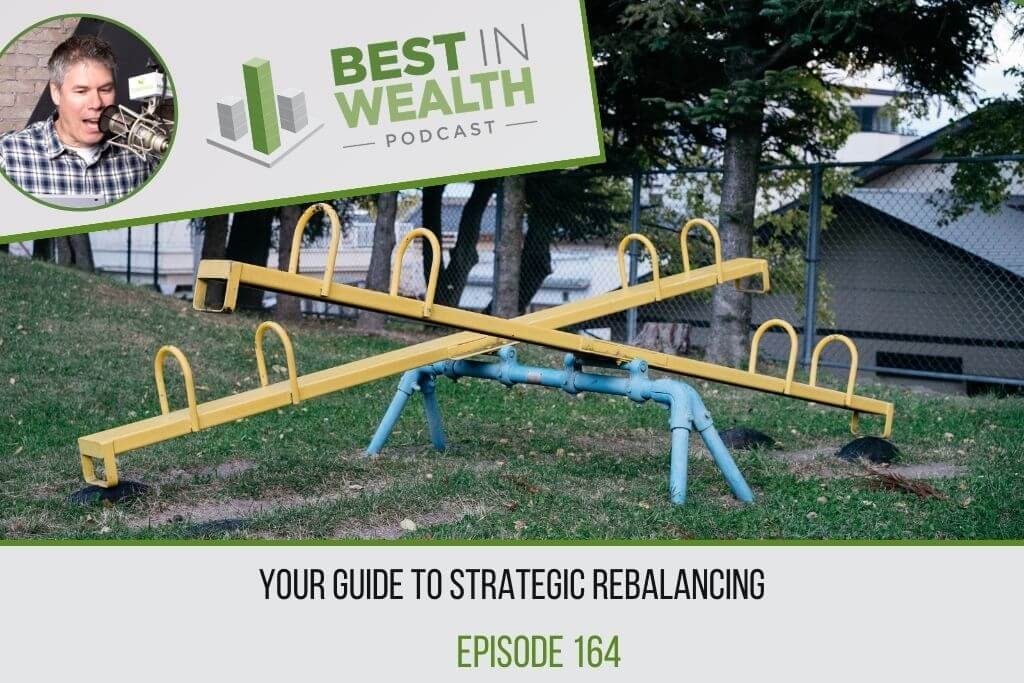Your Guide to Strategic Rebalancing, Ep #164

What is strategic rebalancing? Why should you rebalance your portfolio? How do you rebalance your portfolio? In this episode of the Best in Wealth Podcast, I share what it is, why you want to do it, and the best way to strategically rebalance your portfolio. Don’t miss it!
This episode of the Best in Wealth podcast is your guide to the strategic rebalancing of your portfolio. Check it out! #wealth #retirement #investing #PersonalFinance #FinancialPlanning #RetirementPlanning #WealthManagement #Balance Click To TweetOutline of This Episode
- [2:37] Cleaning out my junk drawer
- [5:15] What is strategic rebalancing?
- [9:09] Rebalancing reason #1: Risk tolerance
- [12:14] Rebalancing reason #2: Buy low and sell high
- [14:05] Time-based portfolio rebalancing
- [18:22] Employ strategic rebalancing
- [22:05] Invest in the low performers
What is strategic rebalancing?
What is strategic rebalancing? Why do you do it? Let’s say you have allocated your 401k into five different mutual funds. For example, you may be invest 20% into the following asset classes; a US fund, an international fund, an emerging markets fund, a real estate fund (REIT) and a bond fund.
Then, over time as the market goes up and down, let’s say the US markets are down and the international market is doing well. Your 20% allocation in the US mutual funds drops to 18% and your international funds might be at 23%. Now, your portfolio is out of alignment. Rebalancing a portfolio is getting it back to square one, with each fund at 20%. But there are different ways to go about it.
The TWO big reasons to rebalance
At Fortress Planning Group, we define risk between 1 and 99. “1” means you hide your money under your mattress (and have next to zero risk tolerance). If you are a “99,” you are able to invest in volatile stocks (you have a high risk tolerance). Your risk tolerance should be somewhere in-between 1 and 99.
You set your portfolio to a certain risk level because it fits your risk tolerance. The market will go up and down. You cannot time it. But if your risk tolerance is a 65 and you are in a portfolio that is a 70, you may not be able to handle a volatile market. Your emotions will lead to poor decisions.
You need your risk tolerance to be in the right place. You have to rebalance so your risk tolerance stays aligned. You cannot be at risk of making emotional decisions. This is the #1 reason why you rebalance.
Reason #2 is that rebalancing offers you the opportunity to buy low and sell high. If your international mutual fund is doing well and is now at 25% of your portfolio, you can “sell high” to get your portfolio back to 20%. You can then buy your US mutual fund and while it is down, “buy low” and get the fund back up to 20% while it is underperforming.
What is strategic rebalancing? Why do you do it? Learn more in this episode of the Best in Wealth podcast! #wealth #retirement #investing #PersonalFinance #FinancialPlanning #RetirementPlanning #WealthManagement #Balance Click To TweetTime-based portfolio rebalancing
How do you rebalance your portfolio? One option is to do it at a set time monthly, quarterly, or yearly. In most 401ks, you can set it up so that it automatically rebalances. What is the best option? How often should you rebalance?
A Vanguard study says there is no perfect time to rebalance. Rebalancing monthly might be excessive and you may pay too much in fees. If you rebalance too soon, you can miss out on momentum. If recessions and corrections lasted the same amount of time, you could do time-weighted rebalancing. But no one knows how long a recession and correction will last.
If your choice is regular rebalancing, aim for yearly rebalancing. But this is not the method that I recommend. What is?
Strategic rebalancing 101
At Fortress Planning Group, we employ strategic rebalancing as often as we need to. The research suggests this is the way to get the most bang for your buck. We do not want to leave money on the table. We are okay if your balanced portfolio drifts away from the 20% allocations. We set up tolerance bands to determine when to rebalance.
If the mutual fund drifts 5–10% away from its target allocation, it is okay. We set the tolerance bands at 20%. When an allocation creeps up from 20% to 24%, it is now 20% away from its target allocation. We get a trigger to make a trade (and use sophisticated technology to manage this). I sell the proper percentage to rebalance the portfolio.
We use a 20% tolerance band because research suggests that it is the best to use. A 5% tolerance band leads to overly frequent trading and possible fees. Strategic rebalancing is believed my many to be the best way to rebalance a portfolio.
What is the upside of this strategy? What does it allow us to do that boosts the performance of your portfolio? Listen to the whole episode to learn more about the strategic rebalancing strategy we employ.
What is time-based portfolio rebalancing? In this episode of Best in Wealth I share what it is—and what the better strategy is. Don’t miss it! #wealth #retirement #investing #PersonalFinance #FinancialPlanning #RetirementPlanning… Click To TweetConnect With Scott Wellens
- Schedule a discovery call with Scott
- Send a message to Scott
- Visit Fortress Planning Group
- Connect with Scott on LinkedIn
- Follow Scott on Twitter
- Fortress Planning Group on Facebook
Podcast Disclaimer:
The Best In Wealth Podcast is hosted by Scott Wellens. Scott Wellens is the principal at Fortress Planning Group. Fortress Planning Group is a registered investment advisory firm regulated by the Securities Act of Wisconsin in accordance and compliance with securities laws and regulations. Fortress Planning Group does not render or offer to render personalized investment or tax advice through the Best In Wealth Podcast. The information provided is for informational purposes only and does not constitute financial, tax, investment or legal advice.



